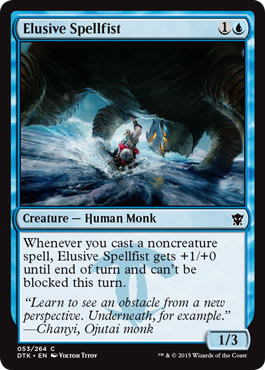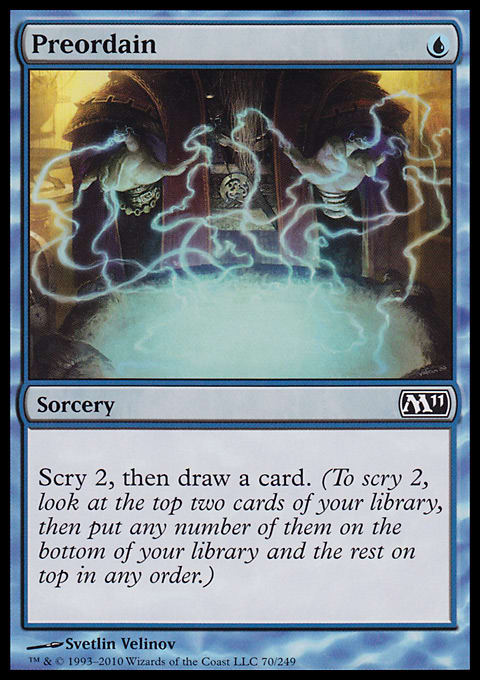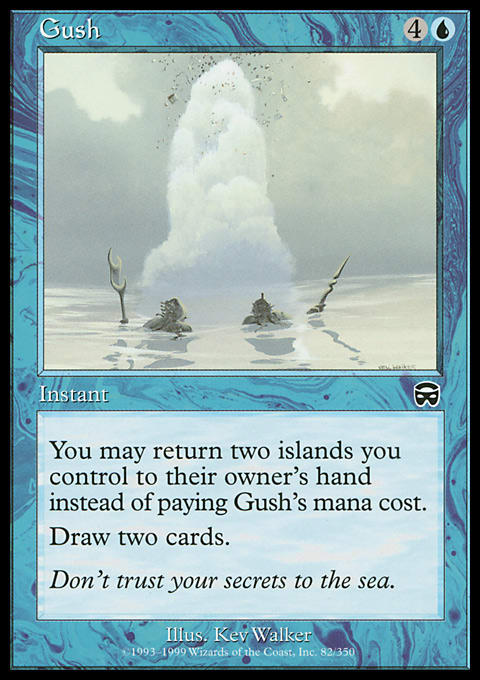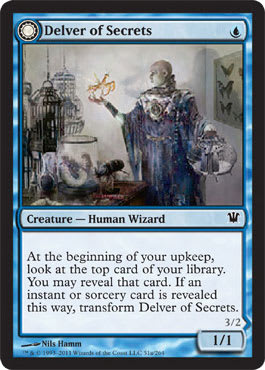Last week I wrote about the power of Gush. In the intervening interval I decided to put my money where my proverbial mouth was and spent the past seven days casting the instant on my main phase. I’ve been generally pleased with the results. I’ve eschewed the combo Gush decks — both Tribe Combo and Izzet Blitz — for a Delver build. My mana base is 16 Islands. Here’s what I’ve been playing.
Spellfist Delver ? Pauper | Alex Ullman
- Creatures (22)
- 1 Ingenious Skaab
- 1 Stitched Drake
- 4 Delver of Secrets
- 4 Elusive Spellfist
- 4 Faerie Miscreant
- 4 Ninja of the Deep Hours
- 4 Spellstutter Sprite
- Instants (13)
- 2 Gush
- 3 Daze
- 4 Counterspell
- 4 Vapor Snag
- Sorceries (9)
- 1 Silent Departure
- 4 Ponder
- 4 Preordain
- Lands (16)
- 16 Island
- Sideboard (15)
- 1 Curse of Chains
- 1 Echoing Truth
- 2 Dispel
- 2 Stormbound Geist
- 3 Coral Net
- 3 Piracy Charm
- 3 Hydroblast
Spellfist Delver takes the traditional Mono-Blue Delver deck and makes a swap at the top end. Spire Golem has been a standard inclusion in Delver decks since the archetype first added Delver of Secrets. The ability to play the 2/4 flyer on turn three naked or turn four with Counterspell backup is a powerful sequence that, for much of Pauper’s history, could throw a wrench in attacks for turns on end. This is no longer the case.
First, we can look at the uptick in Kor Skyfisher decks. Kor Skyfisher, while not killing Spire Golem in combat, matches up well to prevent an unending air assault. Skyfisher also represents decks that are packing Battle Screech, which does a great job of trading either with a Spire Golem or two Insectile Aberrations. The antecedents of Boros Monarch rose to prominence on their ability to beat Delver decks and the current iteration is not any different. Galvanic Blast and Journey to Nowhere matchup well with Spire Golem and the king of the hill has access to both.
The other strike against Spire Golem is the presence of Burning-Tree Emissary Stompy. Spire Golem and Counterspell was a stabilizing turn four that could help the underdog Delver pull close to Stompy. The fact that Stompy — Delver’s longtime natural predator — can now vomit out multiple threats on turn two with ease means that the turn four play is no longer reasonable. As a consequence, Delver decks have started to add Red for Skred and Lightning Bolt while cutting Spire Golem for Augur of Bolas. The result is a deck that is better at dealing with creatures once they have hit the board but lacks a robust creature at the top end.
Cutting to the chase, Elusive Spellfist is not sturdier than Spire Golem. It is vulnerable to Lightning Bolt and in general is far more fragile. It also never comes with a discount. The advantage of Spellfist resides in its pseudo-Prowess. For each noncreature spell cast, the Spellfist gets a power boost, but more importantly it cannot be blocked that turn. This turns every Ponder and Preordain cast in the midgame into an actual offensive threat. Spellfist Delver operates on the conversion of mana to damage.
The inclusion of Elusive Spellfist in Delver gives cantrips additional utility. While these cards have always been fantastic in the early game, they are less stellar (though still strong) when mana is abundant and spells are scarce. I want to be clear: Ponder and Preordain are amazing at all points in a game, but casting one on turn 10 is a lot less backbreaking than one used in the first few turns to enhance card quality. Spellfist turns these spells directly into damage and chaining them together compounds the issue. And that is to say nothing about Gush.
Gush sends Elusive Spellfist into overdrive. Floating two mana and casting Gush for its alternate cost to draw into cantrips can eat away at a fifth of an opposing life total in a single attack. The ability to deal damage in bursts makes a card like Vapor Snag attractive. Not only does Vapor Snag pump Spellfist and deal a point of damage, it also clears out blockers so another attacker can get in a hit. When stacked together, this version of Delver is better at applying offensive pressure than other Mono-Blue versions.
The key here is in the colors. Currently the most popular version of Delver is one that runs Red. By eschewing Mountains we lose the ability to permanently remove creatures via burn spells. At the same time the deck makes concessions to its mana base by running Ash Barrens and Evolving Wilds to find the correct lands. These two lands work in concert with Brainstorm to shuffle away dead cards in favor of fresh cards. It’s a slower version of Brainstorm/Fetchland from Legacy and Vintage, but it is still a potent interaction. Their Ponders and Preordains are slightly worse than those of a mono-Island mana base since they are often pressed into finding a specific land rather than any land. Combine this with the time investment needed to effectively use Ash Barrens and Evolving Wilds and the cost of a second color starts to add up.
Of course, the ability to run true removal (and sideboard all stars) is absolutely worth it in some cases. But here’s the rub — in all my games with Spellfist Delver, I have rarely run into a situation where Vapor Snag was significantly worse than a Red spell and had it matter. There is something to be said for the ability to contain Stompy but here’s a little secret: Stompy isn’t a terrible matchup for Mono-Blue Delver anymore.
Stompy, despite its ability to pump a ton of power on to the table thanks to Burning-Tree Emissary, has optimized itself to beat the current metagame. The top is Izzet Delver, Stompy, and Boros Monarch. In order to attack these decks Stompy has moved to a more tap-out game with cards like Silhana Ledgewalker and Elephant Guide. While these cards can be problematic, they are by no means insurmountable. Stompy has also cut other pump spells to maximize on Hunger of the Howlpack, which is great against removal. Mono-Blue Delver doesn’t run any real removal. Combined, this means the matchup, at least pre-board, is a lot better than history would have us believe.
Spellfist Delver is a fun option for attacking the current Pauper metagame. It has all the best stack control elements from its namesake while adding a serious offensive punch. However the deck has a relatively tight design. There are a few flex slots but most of the cards are there because they have to be. And it all starts with 16 Islands.
Pauper, like every format, is defined by its mana. While the mana is the best it has ever been, monochromatic decks still have an edge. Spellfist Delver can get away with running so few lands since, for all intents and purposes, its curve ends at two mana. Combined with eight 1-mana filter spells and it becomes easy to hit the first four land drops. Most of the time, that is all you need and extra lands can be held to bluff more action. That’s not a hard and fast rule — matchups necessitate reevaluating the importance of extra cards in hand. I can imagine adding an additional Island but I could not see going down to 15 — the risk is too great.
Delver of Secrets and Elusive Spellfist are the main sources of offense. Four copies of Delver are a must. An early flipped Delver applies pressure like little else in the format while also being one of the best answers to opposing Delvers. Elusive Spellfist gets better in multiples but I can see situations where you only want three copies. That being said, if you want fewer than four copies, there is a good chance you want to be running a bigger version of Delver, complete with Spire Golem.
Faerie Miscreant and Spellstutter Sprite are a potent one-two punch. Spellstutter Sprite is one of the best counters available and being able to power it up with a creature that replaces itself a good percentage of the time is pretty darn good. These two also get better with Ninja of the Deep Hours — another Delver staple. No matter what, you will want four copies of each Faerie. While extra copies of Ninja of the Deep Hours can sometimes be stranded in hand you absolutely want to run all four.
Ponder and Preordain are absolute musts and you shouldn’t go below four copies. I would love to run a third copy of Gush but they are not great in the early game. As such that slot is better spent on something else. These cards all help to keep the deck moving forward while also pumping up Spellfist.
The counter suite consists of four Counterspell (a must) and three Daze. Daze is excellent in this deck as it can reset land drops. The problem with Daze is it gets worse as the game goes on. You could run the full four or you could cut them entirely for a more robust counter.
Vapor Snag is our main tempo tool. It is sometimes correct to use it on our own creatures, which is less than ideal but not a hardship in the matchups where you want to Snag your own team. Unsummon might work, but losing out on that damage will matter. Snap is another option, but the initial cost of two mana fights with Elusive Spellfist. Snap is best when used to untap the lands and cast another spell but Spellfist Delver wants to be casting its namesake on turn two — not automatically holding up mana. As such, Snap is an option of the flex slots but hardly a must have.
Speaking of those flex slots, there are three of them. Currently I am running a single Silent Departure for more board clearing action, a Stitched Drake to provide a sturdy body, and an Ingenious Skaab. The Skaab is similar to Spellfist in function but its ability to pump its power makes it a true late game threat. Once it is on the table, every spell represents an additional two points of damage; and, in this deck, that stacks up quick. I could see running a second copy but that probably happens when you go up to 17 land. Other cards for consideration include Mutagenic Growth, Bonesplitter, Piracy Charm, Gitaxian Probe, Jeskai Sage, Looter il-Kor, Into the Roil, or any 2-mana counter.
Spellfist Delver is a new take on an old classic. It takes the traditional Delver deck and, with a small change, completely alters the texture of the deck. Elusive Spellfist turns cheap cards into damage. Let’s be real, pump spells are always better when they draw you a card. Now, Spellfist Delver may not upend the metagame — Boros Monarch will see to that — but it has game against just about everything else. The final reason to try to deck is perhaps the most simple: playing Blue cards in Pauper is rarely a bad choice.


























